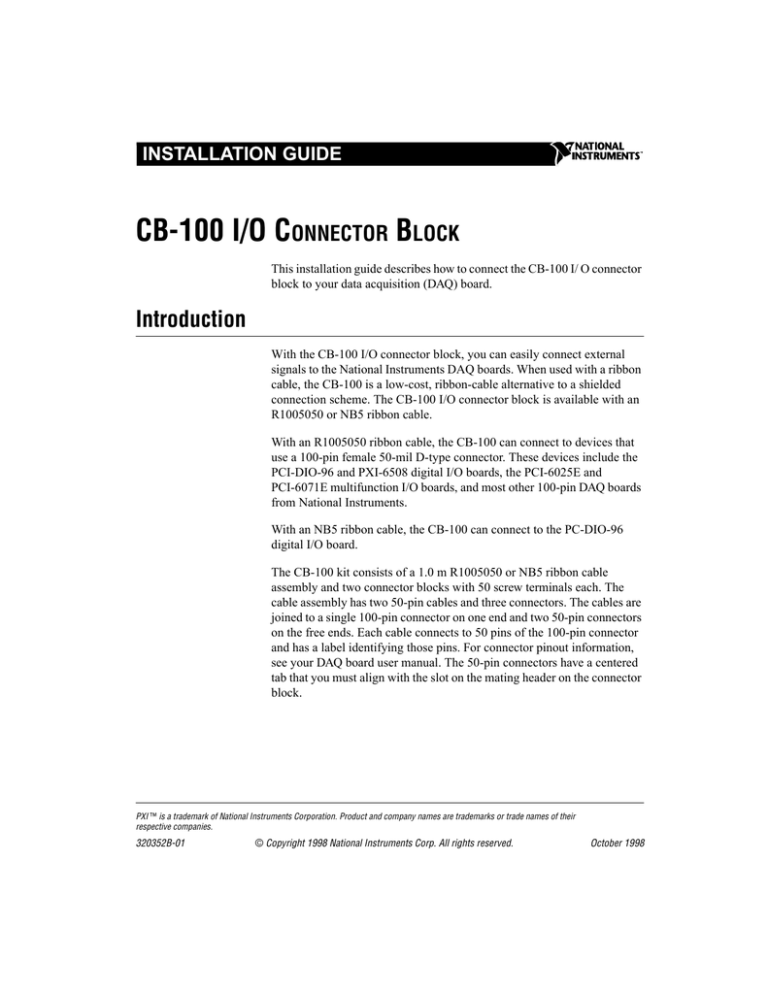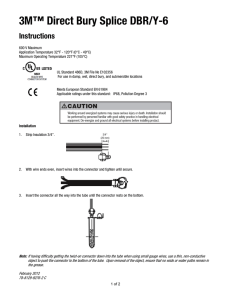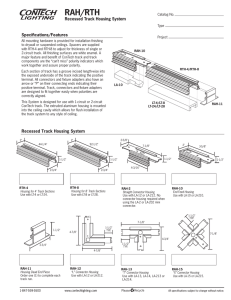
INSTALLATION GUIDE
CB-100 I/O CONNECTOR BLOCK
This installation guide describes how to connect the CB-100 I/ O connector
block to your data acquisition (DAQ) board.
Introduction
With the CB-100 I/O connector block, you can easily connect external
signals to the National Instruments DAQ boards. When used with a ribbon
cable, the CB-100 is a low-cost, ribbon-cable alternative to a shielded
connection scheme. The CB-100 I/O connector block is available with an
R1005050 or NB5 ribbon cable.
With an R1005050 ribbon cable, the CB-100 can connect to devices that
use a 100-pin female 50-mil D-type connector. These devices include the
PCI-DIO-96 and PXI-6508 digital I/O boards, the PCI-6025E and
PCI-6071E multifunction I/O boards, and most other 100-pin DAQ boards
from National Instruments.
With an NB5 ribbon cable, the CB-100 can connect to the PC-DIO-96
digital I/O board.
The CB-100 kit consists of a 1.0 m R1005050 or NB5 ribbon cable
assembly and two connector blocks with 50 screw terminals each. The
cable assembly has two 50-pin cables and three connectors. The cables are
joined to a single 100-pin connector on one end and two 50-pin connectors
on the free ends. Each cable connects to 50 pins of the 100-pin connector
and has a label identifying those pins. For connector pinout information,
see your DAQ board user manual. The 50-pin connectors have a centered
tab that you must align with the slot on the mating header on the connector
block.
PXI ™ is a trademark of National Instruments Corporation. Product and company names are trademarks or trade names of their
respective companies.
320352B-01
© Copyright 1998 National Instruments Corp. All rights reserved.
October 1998
What You Need to Get Started
You need the following to install your CB-100:
❑ CB-100 kit:
•
1.0 m R1005050 or NB5 cable assembly
•
Interface assembly
–
Connector blocks
–
Ejector ears
–
Flush-mount brackets
–
Rail-mount brackets
•
Screwdriver
•
CB-100 I/O Connector Block Installation Guide
If your kit is missing any of the components, contact National Instruments.
Installation
!
Caution
Although the connectors are keyed, it is possible to force the connectors into the
header the wrong way. You must be absolutely certain that the connectors are
properly aligned. Failure to do so could cause signals to be connected to the wrong
pins, which could damage the DAQ board and the computer. National Instruments
is NOT liable for damage resulting from such connections.
1.
Plug the 100-pin connector into the 100-pin rear panel connector on
the board.
Figure 1 shows the connection from the R1005050 ribbon cable to a
100-pin DAQ device.
CB-100 I/O Connector Block Installation Guide
2
© National Instruments Corporation
Figure 1. Connecting the R1005050 Ribbon Cable
Figure 2 shows the connection from the NB5 ribbon cable to the
PC-DIO-96.
Figure 2. Connecting the NB5 Ribbon Cable
2.
Firmly push in the connector for proper contact.
3.
Insert one pair of the ejector ears into each connector block as shown
in Figure 3.
© National Instruments Corporation
3
CB-100 I/O Connector Block Installation Guide
Ejector Ears
Connector
2
01
2 4
14
16
18
20
20
1
6 8
3
5
1
7 9
5
32
42
44
46
48
50
27
29
31
33
35
9
73
41
43
45
47
49
3
12
92
71
51
31
11
1
24
40
43
23
03
83
2
26
8
63
Figure 3. Inserting the Ejector Ears into the Connector Block
4.
If you plan to mount your connector blocks for stability, choose one of
the following procedures for mounting. If you do not want to mount
your connector blocks, proceed to step 6.
•
For flush mounting, insert the flush-mount brackets into the
connector block base as shown in Figure 4.
Flush-Mount Bracket
2 4
10
6 8
12
14
16
18
20
1
3
5
3
12
25
44
46
48
50
27
29
31
33
7
53
39
41
43
45
47
49
3
92
71
51
31
11
1
7 9
20
42
63
43
23
03
83
62
2
24
0
84
Figure 4. Inserting the Flush-Mount Brackets
Place the connector block where you want to mount it and screw
it into place.
CB-100 I/O Connector Block Installation Guide
4
© National Instruments Corporation
•
For rail mounting, pry off the right and left ends of the connector
block with a screwdriver as shown in Figure 5.
Figure 5. Removing the Connector Block Ends
Insert the rail-mount bracket into the slots on the bottom of the
connector block as shown in Figure 6.
Rail-Mount Bracket
Figure 6. Inserting the Rail-Mount Bracket
Replace the end of the connector block and push very firmly until
it snaps into place. Repeat for the other side, making sure that both
rail-mount brackets are facing the same direction.
Slide the rail-mount brackets of the connector block onto your
rails.
© National Instruments Corporation
5
CB-100 I/O Connector Block Installation Guide
5.
Repeat the mounting procedure in step 4 for the second connector
block.
6.
Plug one of the 50-pin connectors on the free end of a ribbon cable into
one of the connector blocks. Align the tabs and arrows as shown in
Figure 7.
Align Keying Tabs
2
01
Align Arrows
2 4
14
16
18
20
20
1
3
5
7
13
28
30
32
34
36
15
17
19
21
5
32
27
29
31
33
35
3
37
9
74
54
34
14
94
2
1
6 8
1
91
6
42
0
85
64
44
24
04
4
38
2
Figure 7. Connecting the Cable to the Connector Block
7.
Firmly push in the connector until the ejector ears on the block header
connector snap into position.
8.
Repeat steps 6 and 7 for the remaining 50-pin connector on the free end
of the cable and the remaining connector block.
Notice that signals are labeled 1 through 50 on both of the connector
blocks. For the cable labeled positions 1-50, the connector block numbers
correspond to the rear panel I/O connector pin numbers on the board. The
numbers appearing on the connector block for the second cable, which is
labeled positions 51-100, are offset by 50.
CB-100 I/O Connector Block Installation Guide
6
© National Instruments Corporation
Removal
1.
Press down on the ejector ears of the connector block. The connector
will pop out.
2.
At the other end, grasp the ribbon cable near the connector end and
gently pull it away from the board with a rocking motion.
© National Instruments Corporation
7
CB-100 I/O Connector Block Installation Guide




